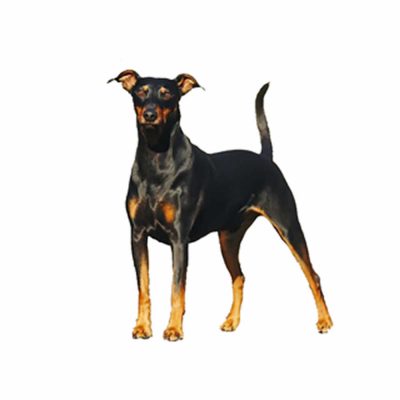German Pinscher
Group 6: Utility
Height: 43 – 48cm
Energy Level: Moderate to high
Original Function: Ratting
Lifespan: 10 – 15 yrs
Recommended for: Experienced dog owners, active people and families with older children.

Group 6: Utility
Height: 43 – 48cm
Energy Level: Moderate to high
Original Function: Ratting
Lifespan: 10 – 15 yrs
Recommended for: Experienced dog owners, active people and families with older children.

The German Pinscher may look like a small Doberman but is in fact a more ancient breed. They originated in Standard Schnauzer breeding several hundred years ago. There were both smooth-coated and wire-coated puppies.
The smooth wes bred to the smooth (resulting in German Pinschers) and the wire was bred to the wire (resulting in Standard Schnauzers). The German Pinschers were recognised in 1879 in Germany and the Pinscher Schnauzer Klub was founded in 1895 in Germany. The Pinscher is the German equivalent of the terrier (Pinscher actually means terrier in German).
They were originally bred to kill vermin in barns. They are very quick and oriented to sight and motion. The rural people prized the dogs for their hunting abilities. They were also taken to market to guard the wagons and were selectively bred for their guarding instinct.
They are good natured, playful and good with children. They are a very alert and loyal companion and they make good guard dogs. The German Pinscher is still considered a rare breed today.
Appearance: Well balanced, smooth coated, medium size with elegant and flowing outlines but strong and well muscled. Eyes dark. Ears high set, V shaped with tips falling forward.
Temperament: High spirited and self-possessed.
Characteristics: Alert, good natured, playful. Loyal, watchful and fearless. Strong willed.
Colour: Short and dense, smoothly fitting, glossy without bald spots.
Coat: All solid colours from fawn to stag red in various shades. Black and blue with reddish/tan markings. In bi-coloured dogs sharply marked red/tan markings desirable. Markings distributed as follows: – at cheeks, lips, lower jaw, above eyes, at throat, at forechest as two triangles separated from each other, at metatarsus, forelegs, feet, inner side of hindlegs and vent region.
Grooming: They have a low maintenance coat, little effort is required to keep the coat looking good. The coat can be cleaned by a rub down with a damp cloth. Be sure to also clean ears and clipping nails regularly.
Exercise- They don’t need excessive exercise; about a half hour per day. They are a very intelligent dog and mental stimulation is equally as important, this will help prevent boredom, which can lead to destructiveness. Dog obedience and agility is recommended by breeders as a great physical and mental exercise as well as a lot of fun. Despite their intelligence, the dog does have a short attention span. Training sessions should be short and direct with plenty of praise and rewards.
Health: Generally a healthy breed. It is tested for Hips/Elbows and Eyes in most countries. This breed is known to become easily overweight if overfed.